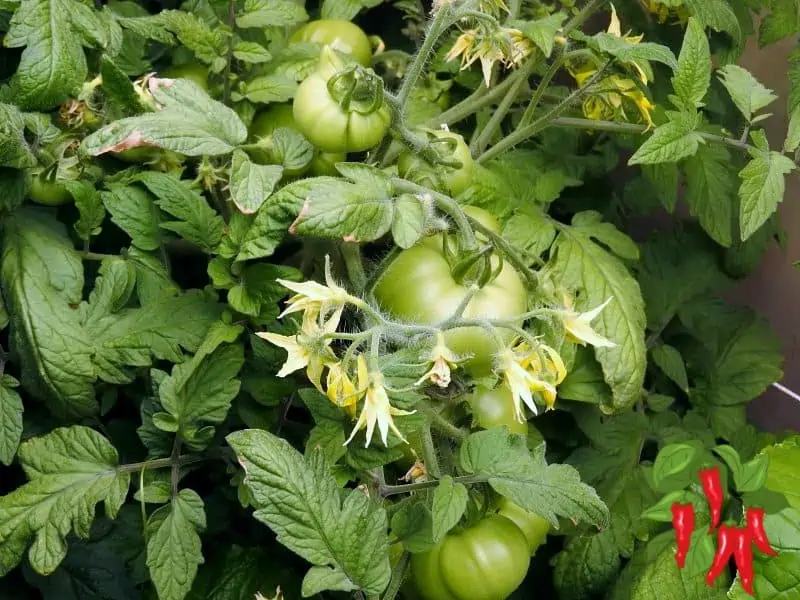This post may contain affiliate links. If you buy something from one of our links we may earn a commission. Thanks
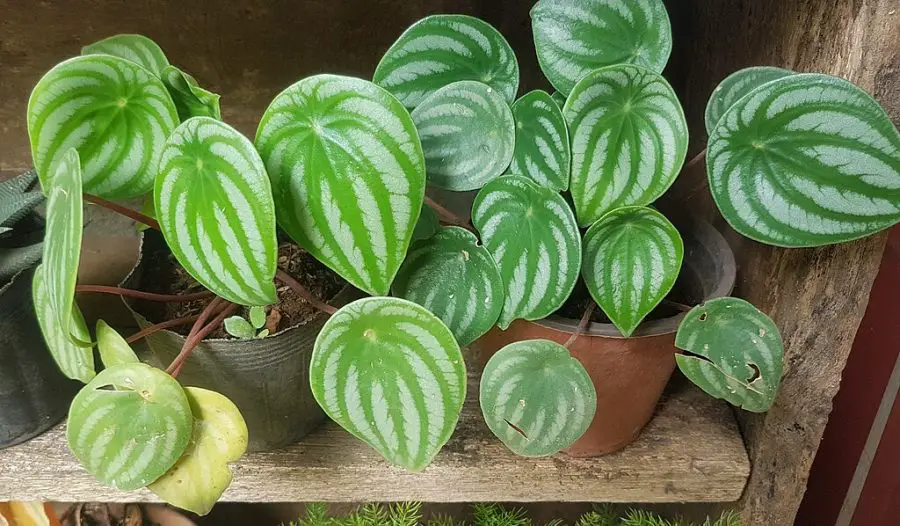
Caring for Peperomia is easier than you think! Learn expert tips for watering, light, and soil needs to help your Peperomia thrive in your home.
Peperomia Care Key Takeaways
- Caring for Peperomia requires bright indirect light, well-draining soil, and moderate watering.
- Keep them in temperatures between 65-75°F and maintain average household humidity.
- Water when the top inch of soil feels dry.
- Use a well-draining potting mix for best results.
- Make sure to use a pot with drainage holes
Caring for Peperomia: A Complete Guide How To Grow Peperomia
Caring for Peperomia might seem tricky with so many varieties and conflicting care advice out there.
When you understand their basic needs, these charming plants are actually some of the easiest houseplants to grow.
Let me show you exactly how to help your Peperomia thrive with simple, proven care tips.
Understanding Peperomia
Peperomia plants are fascinating little gems that often cause confusion among indoor gardeners.
With over 1,500 species in the wild, these adaptable plants have evolved to grow in various conditions, from rainforest floors to semi-arid regions.
Their diversity makes them incredibly versatile for home growing, but also leads to some interesting questions about their true nature.
Is Peperomia a Succulent?
While Peperomias have thick, fleshy leaves that might remind you of succulents, they’re not true succulents.
They belong to their own family (Piperaceae) and are actually related to black pepper plants!
They do share some succulent-like features, such as water-storing leaves and stems, which helps them survive occasional dry spells.
The world of Peperomia offers something for everyone, with varieties sporting different leaf shapes, colors, and patterns:
Popular Peperomia Varieties
Peperomia plants are known for their diverse appearances and compact size, making them a favorite among houseplant enthusiasts. Here are some of the most popular varieties to consider for your indoor collection:
1. Peperomia Obtusifolia (Baby Rubber Plant)

Live Baby Rubber Plant – 4” Small Pot Peperomia Obtusifolia from California Tropicals, Ideal Gift for Office, Garden, Home Decor, Indoor and Outdoor Easy Care Green Plant
- Description: Features thick, glossy, oval-shaped leaves that come in green or variegated patterns.
- Care: Thrives in bright, indirect light but can tolerate lower light conditions.
2. Peperomia Argyreia (Watermelon Peperomia)
 BubbleBlooms Watermelon Peperomia argyreia Water Melon Pep in a 4 inch Pot
BubbleBlooms Watermelon Peperomia argyreia Water Melon Pep in a 4 inch Pot
- Description: Known for its stunning leaves with silvery stripes that resemble watermelon skin.
- Care: Prefers consistent humidity and indirect sunlight.
3. Peperomia Caperata (Ripple Peperomia)

BubbleBlooms Red Emerald Ripple Peperomia in a 4 inch Pot Pep Caperata
- Description: Boasts deeply ridged, heart-shaped leaves that come in shades of green, red, or even silver.
- Care: Enjoys moderate humidity and bright, indirect light.
4. Peperomia Prostrata (String of Turtles)
 String of Turtles Live Plant Hanging Basket, Peperomia prostrata, Live Succulents Plants Live Houseplants, House Plants Indoors Live Indoor House Plants, Peperomia Live Plant Basket by Plants for Pets
String of Turtles Live Plant Hanging Basket, Peperomia prostrata, Live Succulents Plants Live Houseplants, House Plants Indoors Live Indoor House Plants, Peperomia Live Plant Basket by Plants for Pets
- Description: A trailing variety with tiny, round leaves resembling turtle shells, perfect for hanging planters.
- Care: Requires well-draining soil and minimal watering.
5. Peperomia Hope (Peperomia Tetraphylla)

BubbleBlooms Peperomia Hope in a 4 inch Pot rotundifolia
- Description: Features small, rounded leaves on trailing stems, making it ideal for shelves or hanging baskets.
- Care: Adaptable to various lighting conditions but prefers bright, indirect light.
6. Peperomia Rosso (Peperomia Caperata)

Rooted Peperomia Rosso, Peperomia Caperata, Live, Live Indoor, Home Decor, Easy to Grow, Easy to Care, Outdoor Garden and Low Maintenance Houseplant, 4 inch Pot
- Description: Displays dark green leaves with red undersides, creating a striking contrast.
- Care: Requires regular watering but benefits from letting the soil dry out between waterings.
7. Peperomia Graveolens (Ruby Glow)
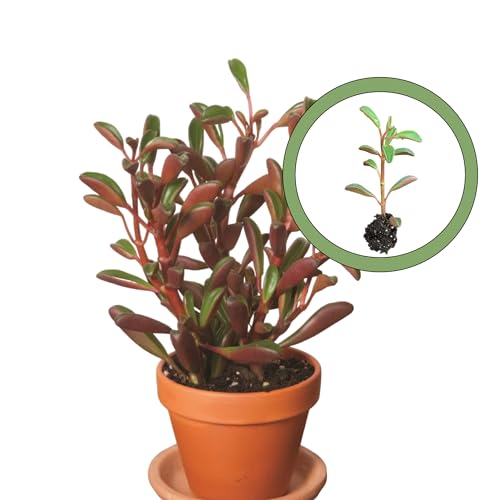
Generic Peperomia Graveolens Ruby Glow Starter Plant, Natural
- Description: Unique with red-tinted stems and fleshy green leaves, giving it a vibrant appearance.
- Care: Prefers a sunny windowsill with well-draining soil.
8. Peperomia Clusiifolia (Ginny Peperomia)

Peperomia Ginny Live Plant for Indoor | Different Houseplants in 4” & 6” Pot | Real House Plant Decor for Living Room, Office, Desk & Bathroom | Ginny | Peperomia clusiifolia
- Description: Features colorful, variegated leaves with pink, green, and cream edges.
- Care: Tolerates a range of light levels and enjoys moderate watering.
9. Peperomia Polybotrya (Raindrop Peperomia)
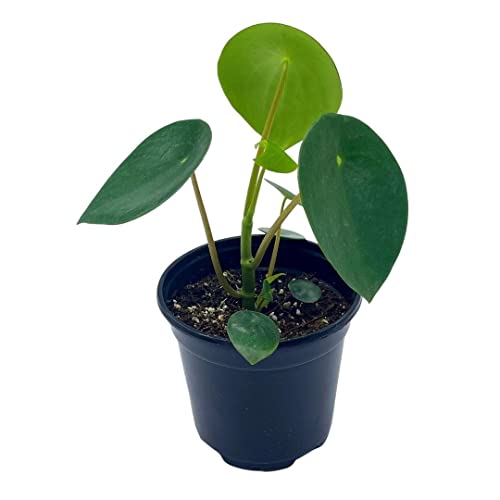
BubbleBlooms Peperomia Polybotrya in a 4 inch Pot Raindrop Tear Drop Pilea Pixie
- Description: Recognized for its large, raindrop-shaped leaves that create a bold statement.
- Care: Thrives in medium to bright indirect light and consistent watering.
10. Peperomia Ferreyrae (Happy Bean)
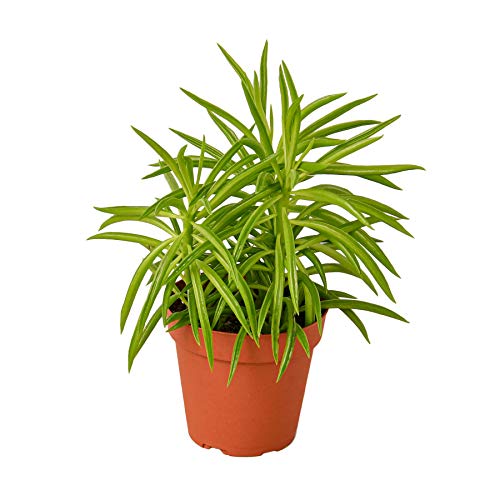
House Plant Shop | Peperomia ‘Green Bean’ – 4″ Pot | Live Indoor Plant | Easy to Care | Natural Décor Plant | Great Gifts| Free Care Guide
- Description: Slender, bean-shaped leaves with a bright green hue, giving it a cheerful look.
- Care: Requires bright light and infrequent watering.
With their wide range of shapes, colors, and growth habits, Peperomia varieties offer something for every plant lover. Whether you prefer trailing vines or compact foliage, there’s a Peperomia to match your style and space!
Does Peperomia Flower?
Yes, Peperomias do flower, but don’t expect showy blooms like you’d see on an orchid.
Their flowers look like little spikes or rat tails (sometimes called “mouse tails”) that stand upright above the foliage.
These flowers are typically cream or pale green and, while interesting, they’re not the main attraction.
The real stars are the beautiful leaves that these plants produce year-round.
Benefits of Growing Peperomia Indoors
If you’re looking for the perfect indoor companion, Peperomias tick all the boxes. These versatile houseplants offer a wonderful combination of good looks and easy care, making them ideal for both sunny apartments and office spaces.
Their compact size and adaptable nature have made them increasingly popular among indoor gardeners.
Indoor Air Quality Enhancement
These little powerhouses work hard while looking good. While Peperomias aren’t the most powerful air-purifying plants, they do help filter indoor air by removing small amounts of toxins.
Their presence adds a touch of nature to your space, contributing to a healthier indoor environment.
Aesthetic Appeal
Peperomias are true decorating superstars that can fit into any style:
- Perfect for small spaces and windowsills
- Great for terrariums and dish gardens
- Excellent desk or tabletop plants
- Beautiful in hanging baskets
- Ideal for mixing in with other houseplants
Low-Maintenance Requirements
One of the best things about Peperomias is how forgiving they are. They don’t need constant attention to thrive, making them perfect for:
- Busy professionals
- Beginners getting started with houseplants
- Office environments
- Those who travel frequently
- Anyone who wants beautiful plants without complicated care routines
Peperomia Plant Size and Growth Habits
Understanding how Peperomias grows helps you plan their perfect spot in your home.
These compact beauties are known for their manageable size and slow-but-steady growth pattern, making them ideal for spaces where you don’t want plants taking over.
Let’s explore what you can expect from these charming houseplants.
Typical Indoor Size
Most Peperomias stay naturally compact, which is part of their appeal. Here’s what to expect:
- Height: Usually 6-12 inches tall
- Spread: Typically 6-8 inches wide
- Compact varieties: Some stay as small as 3-4 inches
- Trailing types: Can extend 12-18 inches in hanging baskets
Growth Rate
Peperomias are slow and steady growers, which is good news for busy people. Their growth pattern is:
- Spring/Summer: Most active growth
- Fall/Winter: Growth slows significantly
- Overall: Expect about 2-4 inches of growth per year
Factors Influencing Size
Several things affect how big your Peperomia will get:
- Container size: Smaller pots keep growth in check
- Light levels: Better light means more growth
- Pruning habits: Regular trimming maintains compact shape
- Variety type: Some naturally stay smaller than others
- Growing conditions: Optimal care leads to fuller plants
Light Requirements for Peperomia
Getting the light right can make all the difference between a thriving Peperomia and one that just survives.
These adaptable plants evolved growing under tree canopies in tropical forests, which gives us great clues about their perfect light conditions.
Understanding their light needs will help you find that sweet spot where your Peperomia will flourish.
Optimal Light Conditions
Finding the right light balance is key to keeping your Peperomia happy:
- Bright indirect light is ideal
- Morning sun is usually fine
- A few feet back from east or north-facing windows works great
- Use sheer curtains to filter harsh direct light
- Rotate the plant regularly for even growth
Tolerance to Low Light
One of the great things about Peperomias is their adaptability to different light levels:
- Can survive in lower light conditions
- Will grow slower in less light
- May become leggy if light is too low
- Variegated varieties need more light than solid green ones
- Office lighting can be sufficient with proper care
Signs of Light Stress
Your Peperomia will let you know if it’s not getting the right amount of light:
Too Much Light:
- Bleached or yellow leaves
- Crispy brown spots
- Wilting despite proper watering
Too Little Light:
- Slow or stopped growth
- Leaves becoming smaller
- Stems stretching toward light
- Loss of variegation
Watering Peperomia
Many people struggle with watering houseplants, but here’s the good news: Peperomias are pretty forgiving on the watering front.
Thanks to their semi-succulent nature, they can bounce back from occasional watering mishaps.
Still, knowing when and how to water will keep your Peperomia looking its best and prevent common problems before they start.
Watering Frequency
Finding the right watering rhythm is more about observation than following a strict schedule:
- Water when top 1-2 inches of soil feels dry
- Check soil moisture with your finger before watering
- Most need watering every 7-10 days
- Water less frequently in winter
- Increase frequency during active growth
Signs of Overwatering and Underwatering
Your Peperomia will give you clear signals about its watering needs:
Overwatering Signs:
- Yellowing leaves
- Soft, mushy stems
- Black spots on leaves
- Leaves falling off easily
- Soil staying constantly wet
Underwatering Signs:
- Wrinkled, limp leaves
- Crispy leaf edges
- Slow growth
- Dried out soil pulling away from pot sides
Best Practices
Follow these tips for successful watering:
- Use pots with drainage holes
- Empty drainage tray after watering
- Water thoroughly until it runs through
- Consider bottom watering for even moisture
- Use room temperature water
- Reduce watering in winter months
Soil and Potting for Peperomia
Getting the right soil mix and potting setup is crucial for happy Peperomias. These plants need a balance between moisture retention and good drainage to thrive.
Think of it like creating the perfect home for your Peperomia’s roots – not too wet, not too dry, but just right. Let’s dive into what makes the perfect growing environment.
Ideal Soil Composition
The right soil mix makes all the difference for healthy growth. Heres a commonly used potting mix:
- 2 parts regular potting soil
- 1 part perlite
- 1 part orchid bark
- Optional: add some coco coir for moisture retention
Understanding Soil Amendments
Coco Coir Benefits
Coco coir is a sustainable alternative to peat moss that offers several advantages:
- Excellent water retention while staying airy
- Naturally resists fungus and bacteria
- Environmentally friendly and renewable
- Helps prevent soil compaction
- Maintains consistent moisture levels
- Rehydrates easily if soil dries out
Perlite Advantages
Perlite is those white, lightweight pieces that look like tiny styrofoam balls, and they’re incredibly beneficial:
- Creates air pockets for root breathing
- Prevents soil from becoming too dense
- Improves drainage significantly
- Keeps soil from compacting
- Lightweight and easy to mix
- Helps prevent root rot
Why Choose Coco Coir and Perlite Over Traditional Mixes
Traditional potting soil alone isn’t ideal for Peperomias. Here’s why a coco coir and perlite-based mix is superior:
- Prevents the common problem of waterlogged roots
- More forgiving if you accidentally overwater
- Maintains consistent moisture without becoming soggy
- Creates ideal air-to-water ratio for root health
- Reduces risk of fungus gnats compared to peat-based mixes
The Perfect Coco Coir Mix Recipe
Here’s a simple but effective mix that outperforms traditional potting soil:
- 70% coco coir
- 30% perlite
- Optional Add some worm castings or compost to the mix
Why This Mix Works Better
Traditional potting mixes often:
- Stay too wet
- Compact over time
- Don’t provide enough aeration
- Can harbor pests
- Become hydrophobic when dry
The coco coir/perlite mix solves these issues by:
- Providing consistent moisture
- Maintaining excellent drainage
- Staying light and airy
- Rehydrating easily
- Supporting healthy root growth
Pot Selection
Choosing the right pot is just as important as the soil:
- Select pots with drainage holes
- Choose containers 1-2 inches larger than root ball
- Terracotta pots work well for moisture control
- Plastic pots are fine but watch watering
- Decorative pots need drainage or use as cache pots
Repotting Guidelines
Peperomias don’t mind being a bit snug in their pots. Here’s when and how to repot:
- Repot every 2-3 years
- Best time is spring or early summer
- Only size up when roots are visible at drainage holes
- Gently loosen root ball when repotting
- Wait a week after repotting before watering normally
Fertilizing Peperomia
Unlike heavy feeders that need constant nutrients, Peperomias are pretty modest when it comes to fertilizer needs.
Think of fertilizing more like giving your plant an occasional vitamin supplement rather than a full meal.
Learning when and how much to feed your Peperomia will help you avoid the common mistake of over-fertilizing.
Nutrient Needs
Peperomias prefer a light touch with fertilizer:
- Feed mainly during growing season (spring/summer)
- Skip fertilizing in fall/winter
- Use balanced, water-soluble fertilizer
- Dilute to half strength of package directions
- Feed every 4-6 weeks during growing season
Fertilizer Types and Application
Choose from these fertilizer options:
- All-purpose houseplant fertilizer (balanced 10-10-10)
- Natural options like worm castings
- Slow-release pellets for steady feeding
- Liquid fertilizers for easy application
- Organic fish emulsion (use outdoors due to smell)
Avoiding Over-Fertilization
Too much fertilizer is worse than not enough. Watch for these warning signs:
- Brown leaf tips or edges
- White crust on soil surface
- Stunted growth
- Wilting despite proper watering
- Leaf burn or discoloration
If you notice any of these signs:
- Flush the soil thoroughly with water
- Stop fertilizing for 2-3 months
- Reduce amount when you resume feeding
Temperature and Humidity Preferences
Peperomias are pretty easygoing when it comes to regular household conditions. They evolved in tropical and subtropical regions but have adapted well to indoor living.
Understanding their comfort zone will help you keep them happy without turning your home into a greenhouse.
Optimal Temperature Range
These plants are comfortable in typical indoor temperatures:
- Ideal daytime: 65-75°F (18-24°C)
- Night temperatures: Can handle down to 60°F (15°C)
- Avoid cold drafts from windows/doors
- Keep away from AC vents
- Protect from heating vents in winter
Humidity Requirements
Good news – Peperomias aren’t as fussy about humidity as other tropical plants:
- Average household humidity is usually fine
- 40-50% humidity is ideal
- Can tolerate lower humidity levels
- No need for constant misting
- Higher humidity promotes better growth
Adjusting Indoor Conditions
Simple ways to maintain good growing conditions:
- Group plants together naturally raises humidity
- Use a pebble tray with water
- Place in naturally humid rooms like bathrooms
- Keep away from drying heat sources
- Move plants inward from windows in winter
Maintenance and Pruning of Peperomia
Keeping your Peperomia looking its best doesn’t require endless hours of care. A little regular attention goes a long way in maintaining these charming plants.
Just like giving your hair an occasional trim keeps it healthy, pruning helps your Peperomia stay full and vibrant.
Routine Care Practices
Simple weekly maintenance keeps your Peperomia thriving:
- Rotate the pot quarterly for even growth
- Check soil moisture with your finger
- Remove any dead or yellowing leaves
- Dust leaves gently with a soft cloth
- Look for early signs of problems
Pruning Techniques
Pruning helps maintain shape and encourages bushier growth:
- Trim leggy stems just above a leaf node
- Remove flower spikes after blooming
- Cut back overgrown stems in spring
- Save healthy cuttings for propagation
- Use clean, sharp scissors or pruners
Cleaning Leaves
Clean leaves are healthy leaves:
- Wipe with a damp cloth monthly
- Avoid leaf shine products
- Support leaves while cleaning
- Use lukewarm water
- Clean both top and bottom surfaces
These care practices help:
- Prevent pest problems
- Encourage fuller growth
- Keep leaves dust-free
- Maintain plant shape
- Monitor plant health
Propagating Peperomia
One of the most rewarding aspects of growing Peperomias is how easily they multiply.
Whether you want to share with friends or expand your collection, propagating these plants is surprisingly simple.
You can turn one healthy plant into several new ones with just a few basic supplies and some patience.
Propagation Methods
You have several reliable options for creating new plants:
- Leaf cuttings – fastest and easiest
- Stem cuttings – great for trailing varieties
- Division – best during repotting
- Water propagation – fun to watch roots develop
- Soil propagation – higher success rate
Leaf cuttings Step-by-Step Guide
Here’s how to successfully propagate from leaf cuttings:
- Choose healthy leaves with stems attached
- Cut leaf in half horizontally
- Dip cut edge in rooting hormone (optional)
- Place cut edge down in moist propagation mix
- Cover with clear plastic to retain humidity
- Place in bright indirect light
- Keep soil lightly moist
- Watch for new growth in 3-4 weeks
Tips for Success
Make your propagation efforts more successful:
- Use fresh, sterile potting mix
- Keep temperature around 70-75°F
- Avoid direct sunlight on cuttings
- Don’t overwater – slightly moist is best
- Be patient – roots take time to develop
Stem Cutting Propagation
Stem cuttings are particularly effective for varieties like String of Turtles and other trailing types. Here’s how to do it right:
Selecting Stems
- Choose healthy stems with 2-3 leaf nodes
- Cut 4-6 inches long
- Make cuts just below a leaf node
- Remove leaves from bottom third
- Use stems that are firm, not soft
Propagation Steps
- Cut stems into sections with at least two leaves
- Let cuts dry for 1-2 hours
- Prepare containers with moist propagation mix
- Dip stems in rooting hormone (optional)
- Plant stems about 1-2 inches deep
- Ensure leaves stay above soil
- Cover with clear plastic dome or bag
- Place in bright indirect light
Water Propagation Method
Some prefer starting stems in water:
- Place stems in clean water
- Change water every few days
- Keep nodes submerged
- Wait for roots to grow 1-2 inches
- Transfer to soil carefully
- Keep extra moist first week
Tips for Success
- Take multiple cuttings to ensure success
- Start several stems in one pot for fuller plants
- Expect roots in 2-4 weeks
- Gently tug to check for root development
- Remove any rotting stems immediately
Division Method
Division is a great option when you’re repotting larger, mature Peperomias. It’s one of the quickest ways to get new plants since you’re working with established root systems.
When to Divide
- During regular repotting
- Spring or early summer is ideal
- When plant has multiple stems
- If plant is overcrowded
- When you see natural separation points
Division Steps
- Remove plant from pot carefully
- Gently shake off excess soil
- Locate natural divisions in root ball
- Carefully pull or cut sections apart
- Ensure each section has: • Healthy roots • Several leaves • At least 2-3 stems
Aftercare
- Plant divisions immediately
- Use fresh potting mix
- Keep soil consistently moist
- Provide bright indirect light
- Hold off on fertilizing for 4-6 weeks
- Maintain higher humidity initially
Success Tips
- Work with clean tools
- Don’t divide too aggressively
- Keep roots moist during process
- Size new pots appropriately
- Expect some adjustment period
Common Problems and Solutions
Even the easiest houseplants can run into trouble sometimes. Knowing how to spot and fix common issues keeps your Peperomia thriving.
Most problems are easy to solve if you catch them early, so regular observation is your best defense against plant troubles.
Leaf Discoloration
Different colors signal different problems:
Yellow Leaves:
- Usually indicates overwatering
- Could be too much direct sun
- Might need fertilizer
- Check for root rot
- Aging leaves naturally yellow
Brown Leaves:
- Crispy edges mean too dry
- Soft brown spots suggest overwatering
- Sunburn causes brown patches
- Low humidity can brown tips
- Cold damage browns leaves
Wilting or Drooping
When your Peperomia looks sad, check these common causes:
- Soil too wet or too dry
- Temperature stress
- Root problems
- Too much direct sun
- Recent repotting shock
Stunted Growth
If your plant isn’t growing as expected, investigate:
- Insufficient light
- Poor soil conditions
- Root bound
- Not enough nutrients
- Temperature too cold
Quick Fixes:
- Adjust watering routine
- Move to better light
- Check soil moisture
- Repot if needed
- Maintain stable temperatures
Pests and Diseases Affecting Peperomia
No one likes dealing with plant problems, but catching issues early makes them much easier to solve.
While Peperomias are generally hardy, they can occasionally face some common pests and diseases.
Let’s look at how to identify and treat these issues before they become serious problems.
Common Pests
Here’s what to watch for and how to handle unwanted visitors:
Mealybugs:
- Look like tiny cotton balls
- Hide under leaves and stems
- Treat with neem oil or rubbing alcohol
- Use cotton swab for spot treatment
- Isolate affected plants
Spider Mites:
- Cause tiny speckled leaves
- Create fine webbing
- Regular misting deters them
- Treat with insecticidal soap
- Increase humidity to prevent
Fungus Gnats:
- Tiny flies around soil
- Let soil dry between waterings
- Use sticky traps
- Add cinnamon to soil surface
- Consider repotting with fresh soil
Disease Prevention
Most diseases can be prevented with proper care:
Root Rot:
- Caused by overwatering
- Use well-draining soil
- Check drainage holes aren’t blocked
- Only water when top soil is dry
- Remove affected roots when repotting
Leaf Spot:
- Remove affected leaves
- Avoid getting leaves wet
- Improve air circulation
- Keep leaves dry at night
- Use copper fungicide if needed
Frequently Asked Questions About Caring for Peperomia
Got questions about your Peperomia? You’re not alone! Here are the most common questions answered in simple, practical terms to help you grow these delightful plants with confidence.
Q. Do Peperomia like to be misted?
A. While Peperomias don’t require misting, they can benefit from occasional misting in very dry conditions. However, it’s better to focus on proper watering and good air circulation rather than relying on misting for humidity.
Q. Where is the best place to put a Peperomia?
A. Place your Peperomia in bright indirect light, like near an east or north-facing window. They also do well a few feet back from south or west windows. Avoid direct sun and cold drafts.
Q. Do Peperomia need direct sunlight?
A. No, Peperomias prefer bright indirect light. Direct sunlight can burn their leaves. Morning sun is usually fine, but protect them from harsh afternoon rays.
Q. Is Peperomia a good indoor plant?
A. Yes! Peperomias make excellent indoor plants because they’re compact, adaptable to normal house conditions, and don’t need constant attention to thrive.
Q. Should I bottom water my Peperomia plant?
A. Bottom watering can be beneficial for Peperomias as it encourages deep root growth and prevents overwatering. However, both top and bottom watering methods work well if done properly.
Q. How do you keep Peperomia bushy?
A. Regular pruning, adequate light, and proper fertilization help keep Peperomias bushy. Pinch back leggy growth and rotate the plant regularly for even growth.
Q. Is Peperomia a succulent?
A. While Peperomias have succulent-like features with their thick leaves, they’re not true succulents. They belong to the pepper family (Piperaceae) but share some care requirements with succulents.
Q. How to tell the difference between overwatered and underwatered Peperomia?
A. Overwatered leaves become yellow and mushy, while underwatered leaves become wrinkled and crispy. Check the soil moisture – overwatered soil stays wet, while underwatered soil feels dry and may pull away from the pot sides.
Q. When to repot Peperomia?
A. Repot Peperomias every 2-3 years or when they become rootbound. The best time is during spring or early summer. Only size up one pot size, as they prefer to be slightly rootbound.
How To Grow Peperomia Conclusion
Caring for Peperomia doesn’t have to be complicated. These adaptable little plants reward even minimal care with their charming presence and endless variety of leaf patterns and shapes.
With the right balance of light, water, and attention, they’ll thrive in nearly any indoor space.
Remember these key points for success:
- Bright indirect light is best
- Allow soil to dry slightly between waterings
- Use well-draining soil with plenty of aeration
- Don’t stress about humidity
- Watch for early signs of problems
The best part about Peperomias is their forgiving nature – they’ll bounce back from most care mistakes and continue growing happily.
Whether you’re new to houseplants or an experienced grower, these versatile plants deserve a spot in your collection.
Start with one variety, and don’t be surprised if you find yourself adding more to your collection.
Their compact size, easy care requirements, and beautiful foliage make them perfect for any home or office setting.
Happy growing!
Learn more: Indoor Apartment Gardening: 15 Point Comprehensive Guide
Visit my Amazon Influencer Page for videos and gardening products Grow Your Own Garden






